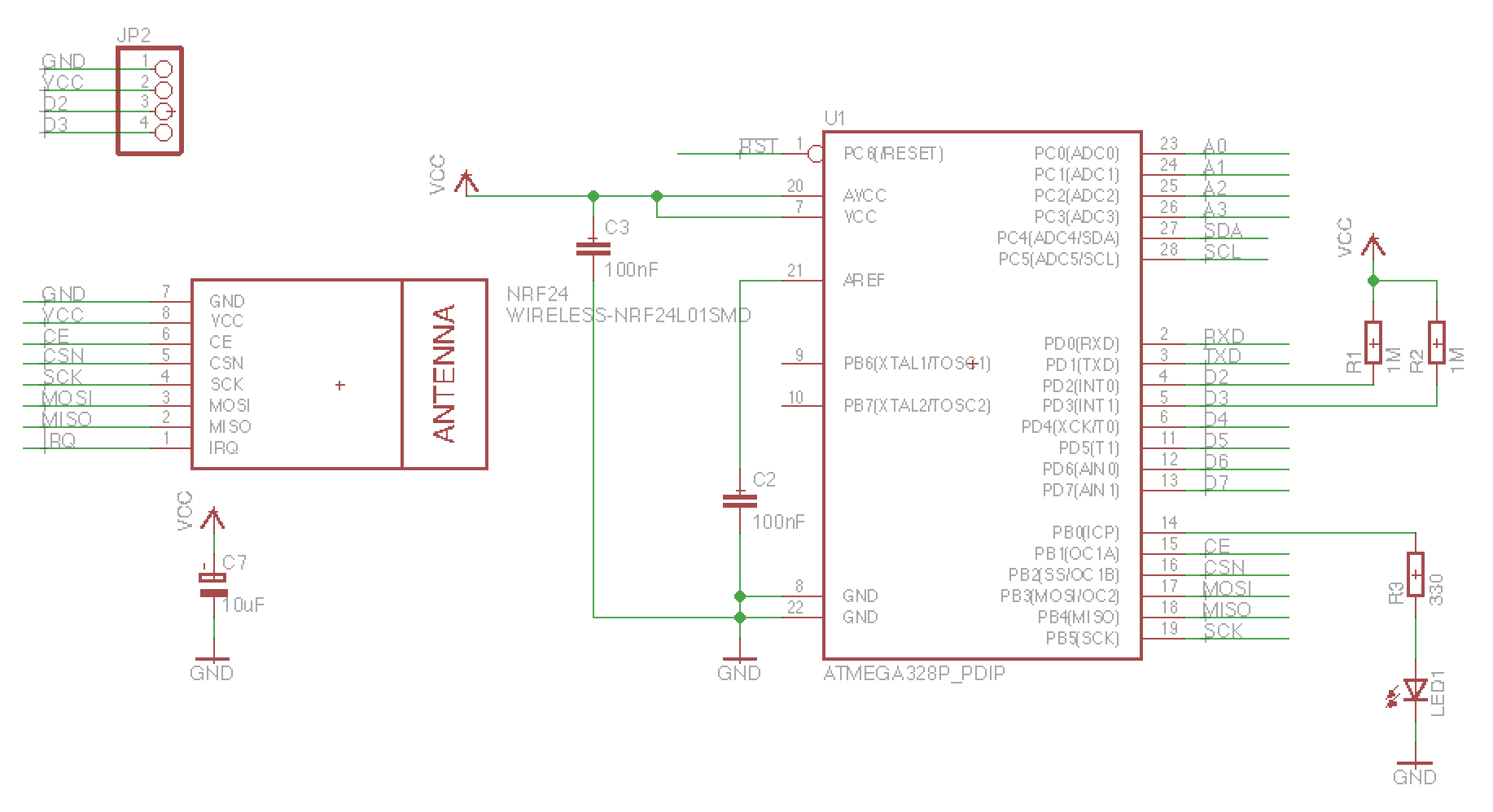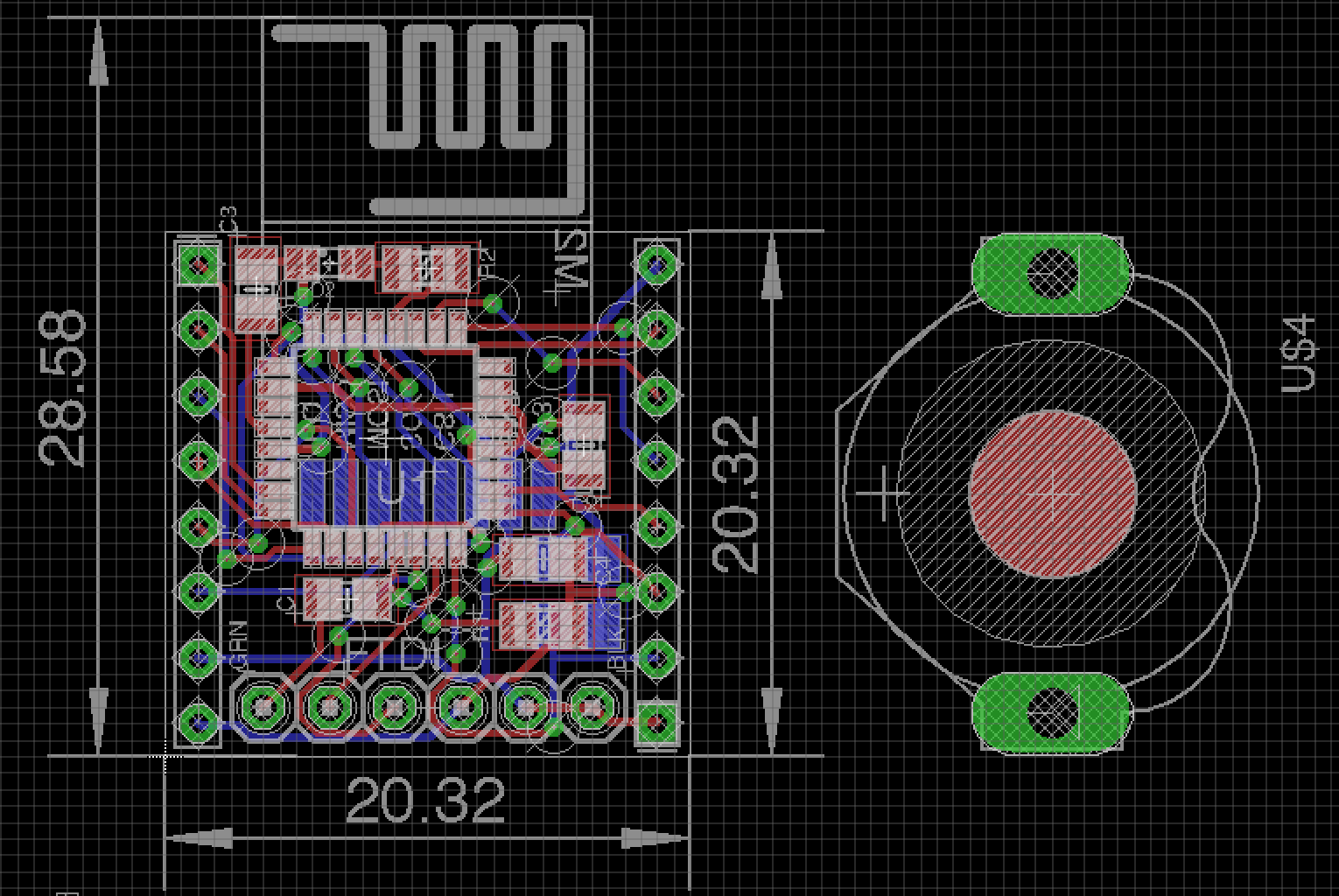New nrf24l01+ smd
-
Propably no difference. I have asked about it a week ago http://forum.mysensors.org/topic/2984/nrf24l01-mini-vs-normal-size-module
-
@AWI No problem, this board is making its way to me via the mail now (was shipped from OSH Park last wednesday).
I'm hoping to test it coming week.
This board one is a one-trick pony. It is based on @m26872's concept of a very narrow board, but in my case I just need it to handle 2 magnetic switches. So pull-up resistors and connection for two contacts (normally closed) is provided (on the pins that allow hardware wake up from power down), and nothing else. No crystal, just minimal power decoupling and a led. No FTDI adapter or ISP. And of course only connection for the SMD version of the NRF24.


While that was being made at OSH Park I prepared a second design, but this one is still in movement (not ordered yet), measurements are in mm:

It is certainly not a Sensebender, as it lacks ATSHA204A, SI7021 and SPIFlash, but it does have FTDI interface and optional pull-ups on D2 and D3. It is my first try at SMD, with 0805 size components (I need to be able to hand solder them).
The objective is to make a working sensor board as flat as possible. At the moment is is even smaller then the CR2032 batteryholder I was planning to use. A possibility is that I go for a two board approach using this "flat node" and a second board to hold a CR1632 (a holder for this smaller battery is in the image above, Keystone Technologies model 3013).
To be continued ...
-
@AWI No problem, this board is making its way to me via the mail now (was shipped from OSH Park last wednesday).
I'm hoping to test it coming week.
This board one is a one-trick pony. It is based on @m26872's concept of a very narrow board, but in my case I just need it to handle 2 magnetic switches. So pull-up resistors and connection for two contacts (normally closed) is provided (on the pins that allow hardware wake up from power down), and nothing else. No crystal, just minimal power decoupling and a led. No FTDI adapter or ISP. And of course only connection for the SMD version of the NRF24.


While that was being made at OSH Park I prepared a second design, but this one is still in movement (not ordered yet), measurements are in mm:

It is certainly not a Sensebender, as it lacks ATSHA204A, SI7021 and SPIFlash, but it does have FTDI interface and optional pull-ups on D2 and D3. It is my first try at SMD, with 0805 size components (I need to be able to hand solder them).
The objective is to make a working sensor board as flat as possible. At the moment is is even smaller then the CR2032 batteryholder I was planning to use. A possibility is that I go for a two board approach using this "flat node" and a second board to hold a CR1632 (a holder for this smaller battery is in the image above, Keystone Technologies model 3013).
To be continued ...
@GertSanders said:
This board one is a one-trick pony. It is based on @m26872's concept of a very narrow board, but in my case I just need it to handle 2 magnetic switches.
This is what I was looking for as I need a small board for a reed switch. Please keep us posted about your testing
-
@GertSanders said:
This board one is a one-trick pony. It is based on @m26872's concept of a very narrow board, but in my case I just need it to handle 2 magnetic switches.
This is what I was looking for as I need a small board for a reed switch. Please keep us posted about your testing
@alexsh1 My very narrow board was built and tested today. It works fine, I posted info on the hardware forum.
I must say I feel pity for this sliver of plastic and metal ...
-
@alexsh1 My very narrow board was built and tested today. It works fine, I posted info on the hardware forum.
I must say I feel pity for this sliver of plastic and metal ...
@GertSanders said:
@alexsh1 My very narrow board was built and tested today. It works fine, I posted info on the hardware forum.
I must say I feel pity for this sliver of plastic and metal ...
Excellent! I ordered your narrow board a few days ago as I thought it would be very useful.
One thing I can tell for sure - cutters are really well built. They are made in Japan and electrostatic safe. Most important they are not big as the ones I had before.
-
@Sweebee Very nice indeed!
I'm very surprised btw that you're using 2xAA to power the PIR. Will it work reliably (no false detections), even when the batteries are running out?
I use 2xAA to power Pro Mini + nRF and an extra AA to power the PIR. This way the supply to the PIR will stay > 3V over time. -
@Sweebee Very nice indeed!
I'm very surprised btw that you're using 2xAA to power the PIR. Will it work reliably (no false detections), even when the batteries are running out?
I use 2xAA to power Pro Mini + nRF and an extra AA to power the PIR. This way the supply to the PIR will stay > 3V over time.@Yveaux the pirs work fine if you only have interrupts with CHANGE. I don't use a sleep timer. If you wake it up every minute or so its unreliable yes. but only with interrupts from the pir it works fine. I have 10 pirs like this. Oldest one is from march 2015 and still running.
-
@Yveaux the pirs work fine if you only have interrupts with CHANGE. I don't use a sleep timer. If you wake it up every minute or so its unreliable yes. but only with interrupts from the pir it works fine. I have 10 pirs like this. Oldest one is from march 2015 and still running.
-
@Yveaux the pirs work fine if you only have interrupts with CHANGE. I don't use a sleep timer. If you wake it up every minute or so its unreliable yes. but only with interrupts from the pir it works fine. I have 10 pirs like this. Oldest one is from march 2015 and still running.
You have an excellent setup - I ordered those adapter as well at oshpark.
@Yveaux has got a point - I have been struggle to build a reliable PIR on 2xAA batteries. I have just started building it now. 1 year battery life and counting is impressive.@Sweebee Would you care to share your code? Maybe there is anything there which gives us some clues though I believe this is more a hardware issue.






